Sample Non-Disclosure Agreement Template
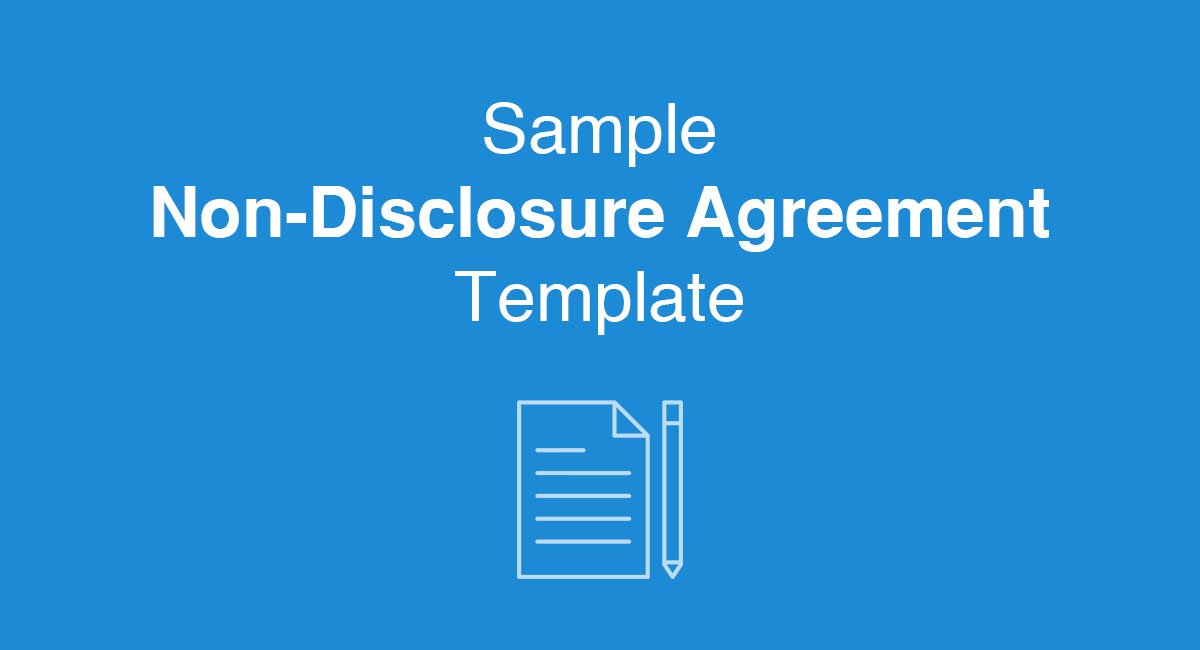
Our Non-disclosure (NDA) template lets you get started with a Non-disclosure agreement. This template is free to download and use.
A NDA can also be known by other names such as a confidentiality, non-use or trade secret agreement.
Essentially, a non-disclosure (NDA) agreement is a legally binding contract between parties that requires them to keep certain information confidential.
If you’re looking for the template, download the PDF file.
Why use a NDA?
NDA agreements are commonly used are in employer-employee hiring situations, between parties who are considering entering into a licensing discussion or agreement with each other, distribution negotiations and between startups and companies who wish to gauge the potential possibility of future commercial joint ventures.
Mutual NDA vs one-way NDA
An NDA agreement can be for the benefit for both parties involved or solely only for one party.
A mutual NDA is created to protect the confidentiality of both parties disclosures but if only one party is intending to make disclosures, then normally only a one-way NDA will be drawn up.
The party that’s making disclosures is normally known as the disclosing party (“Disclosing Party”) while the party that is bound to keep those disclosures confidential is normally referred to as the receiving party (“Receiving Party”).
Here’s an example of a clause that lists the Disclosing and Receiving Parties in a Confidential Disclosure Agreement by the National Institute of Allergy and Infectious Diseases:

Clauses for your NDA
Clause #1: Purpose of the NDA
It’s useful to provide a clause stating the purpose of your NDA agreement as it helps to provide clarity for the direction of the agreement.
Here’s a Statement of Limited Purpose from Microsoft in its “Confidentiality Agreement for Licensing Discussions” to clarify what disclosures the agreement is meant to apply to:

Clause #2: Definition of Confidential Information
Courts also frequently consider whether the definition of what’s considered confidential in the NDA agreement is reasonable and not too broad.
Confidentiality can extend to things such as documents, designs, sketches, analyses, source codes, marketing plans, manufacturing processes and technical procedures.
The Disclosing Party is given the freedom to specify what information will be considered confidential but it should also be able to justify why the information needs to be protected by confidentiality.
Here’s an example of a clause defining what would be considered confidential for the parties in Accuride Corp’s Confidentiality and Non-Disclosure Agreement:

Clause #3: Reasonable scope
It’s also important to examine the scope of your NDA agreement and ensure that it is reasonable.
Some countries and states are particularly against agreements that come across as unreasonably restrictive, onerous or anti-competition.
For example, clauses that prevent a Receiving Party from using his or her industry knowledge and experience and therefore, not being able to earn an income in the same industry in the future might be considered unreasonably restrictive.
For example. in Lasership, Inc. v. Watson, the Virginia court held that the NDA agreement was unenforceable because the requirement of confidentiality applied too broadly and the terms of the agreement were to also apply indefinitely.
Clause #4: Duration of the NDA
Even if the scope of the NDA agreement was reasonable, the agreement may still be struck down if the duration for which confidentiality is meant to apply for is too long.
A perpetual agreement continues to endure as long as the information is considered confidential whilst a NDA agreement with a limited time duration expires once the time duration is reached.
Courts in different jurisdictions view the acceptability of perpetual NDA agreements and clauses differently but in general, courts are more accepting of perpetual agreements and clauses if the information to be protected is a trade secret.
Courts are more likely to frown on perpetual agreements or clauses to cover information that’s merely ordinary confidential information.
For example, in Augusta Medical Complex, Inc. v. Blue Cross of Kansas, Inc., the Kansas court showed clear disfavor against contracts with indefinite time durations.
This is because not all types of confidential information continue to retain value after an extended period of time.
For example, customer lists may no longer be accurate, marketing strategies may become outdated and pricing models may cease to be effective after a certain period of time.
In contrast, courts have ruled that trade secrets have inherent value based on it being kept a secret and therefore, should be protected indefinitely.
In order for a certain type of information to quality as a trade secret, it has to possess commercial value, confer some sort of economic benefit to its owner and reasonable effort must have been made to keep it a secret.
Businesses like Coca-Cola and KFC have managed to keep their trade secrets for 100 years and they invest a considerable amount to protect their trade secrets, treating them with respect and special attention.
California is generally known as a state that’s against anti-competition clauses, but even Californian courts respect the importance of trade secrets.
In Pacesetter Inc. v. Nervicon Co. Ltd, St. Jude Medical alleged that its trade secrets were stolen by an employee engineer and was awarded the amount of $2.3 billion which was later trimmed to $947 million.
Therefore, as a general rule, if you’re merely trying to protect ordinary confidential information, it would be wiser to place a reasonable time duration for secrecy unless there is very good reason that your confidential information needs to be kept secret forever.
You can use NDA agreements to protect trade secrets but make sure that the duration requirement for confidentiality for such information never expires.
In other words, make the NDA agreement to apply perpetually.
If you make the mistake of including a time limitation in your NDA for a trade secret, this would mean that the Receiving Party is no longer obliged to keep your trade secret confidential after the time duration for secrecy has expired.
An example is the case of Silicon Image, Inc. v. Analogk Semiconductor, Inc. where Silicon Image made the mistake of providing a time limitation in its NDA agreement which applied to trade secrets.
If you intend to use the agreement that will be covering both ordinary confidential information and trade secrets, then it is important to make a distinction between those two types of confidential information.
If your agreement will be covered by a jurisdiction that accepts NDAs with perpetual time durations, then you can draft your agreement with no expiry date.
However, if you’re going to be covered by a jurisdiction where perpetual NDA agreement are generally not accepted, then you may be better off having two distinct clauses to cover the two separate disclosure time periods.
Here are some example of clauses from Coca Cola’s Agreement on Confidentiality, Non-Competition and Non Solicitation where Coca-Cola limited the disclosure period for ordinary confidential information to 2 years after termination of employment but required indefinite confidentiality for its trade secrets:
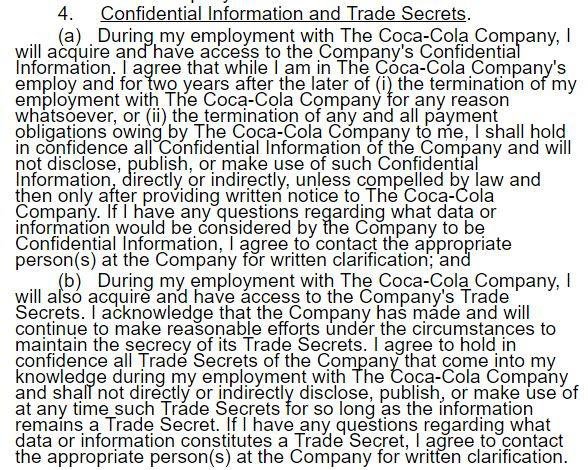
To clarify what information would be considered ordinary confidential information and what would be trade secrets, you should define these two types of information in your NDA agreement.
Using the same Coca Cola’s agreement on “Confidentiality, Non-Competition and Non Solicitation” example, here’s an example:
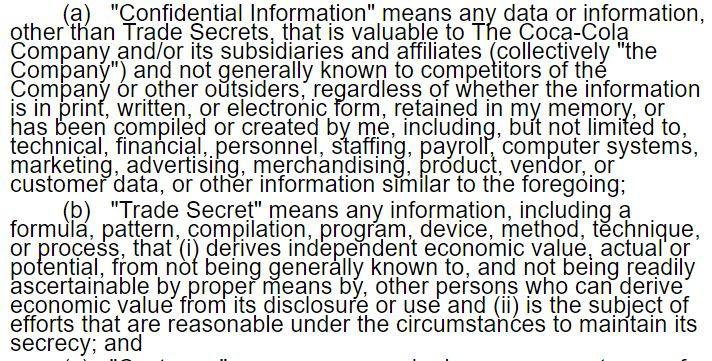
In addition to the definitions, you should ensure that you mark your disclosures appropriately as “CONFIDENTIAL” or “TRADE SECRET” to prevent confusion.
Clause #5: Exceptions to requirement for confidentiality
There are some commonly accepted exceptions for the requirement of confidentiality.
To ensure that your NDA agreement avoids the risk of being invalidated, you should make sure that you include these exceptions into your NDA:
- Exception #1: Information that was provided by a third party prior to your disclosure
This covers the kind of information that the Receiving Party receives from an independent third party, prior to you making any disclosure of that same piece of information.
For example, the Receiving Party receives the information through their own supplier. If that is the case, it would be unreasonable for you to demand that the Receiving Party keep that information confidential when the information was provided by an independent party.
- Exception #2: Information already known by Receiving Party or in public domain
Confidential information that was already known by the Receiving Party or enters the public domain can no longer be considered confidential and you cannot require confidentiality of the Receiving Party if that exposure occurred through no breach or fault on the Receiving Party’s side.
For example, if your information gets published by a careless employee, you cannot enforce the NDA agreement covering the same leaked information against another employee.
In the same vein, if you forget to require one Receiving Party to sign a NDA agreement and that Receiving Party subsequently exposes your confidential information, all other NDA agreements that you signed with earlier Receiving Parties covering that same piece of information cannot be enforced.
In other words, you have to take reasonable action to protect your confidential information at all times.
- Exception #3: The Receiving Party of your confidential information had managed to develop the information independently prior to your disclosure
It’s not unusual that you may end up collaborating with a Receiving Party that does similar work that you do.
For example, if you were a mobile game developer, you may choose to collaborate with another mobile game developer.
Any information that the other mobile game developer develops on their own independently (prior to you making any disclosure of that same sort of information) cannot be claimed as your proprietary information and therefore, cannot be part of the NDA agreement.
- Exception #4: Court-ordered or legally compelled disclosures
There have been occasions where certain parties, such as the government, have been granted the right to force a Receiving Party to disclose confidential information.
An example of such an incident happened in 2011 during the U.S. Government’s investigation of WikiLeaks and one of its volunteers Jacob Appelbaum.
In such cases, parties often choose to breach the NDA rather than a court order.
Although your Receiving Party may not be able to resist the court order, you can request that the Receiving Party give you immediate notice so that you can be prepared and if you wish, apply for legal protective remedies to limit the actual amount of disclosure.
An example of a clause that provides for all these exceptions can be found in the University of Connecticut’s Non-Disclosure and Non-Use agreement:
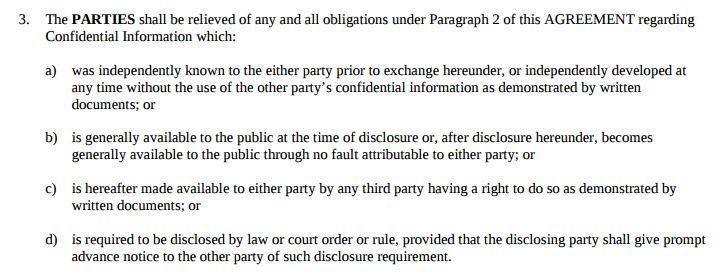
Clause #6: Jurisdiction
In the event that you have to enforce the NDA agreement against a breach by a Receiving Party, the jurisdiction that applies to your agreement will be vital.
As mentioned earlier, different jurisdictions view the restrictiveness of NDA agreement very differently.
If there’s no clear jurisdiction provided for in the agreement, then you may be looking at extra legal costs in order to determine this issue.
To avoid this expensive exercise and to prevent the possibility of a non-supportive outcome, you should state clearly which jurisdiction you want to apply to your NDA agreement:
An example of a clause that provides for jurisdiction can be found in a template NDA from Harvard Business School:

Clause #7: Termination of the NDA
To avoid any confusion, you should also specify what you wish the Receiving Party to do with the copies of confidential information that are in their possession when your NDA agreement ends.
For example, you could require that the other party returns all originals and copies of the information back to you or destroy them within a certain period of time and retain no other records or copies.
An example of such a clause can be found in Thoughtbot’s Mutual Non-Disclosure Agreement:

Clause #8: Legal remedies
Normally, a NDA agreement provide for both monetary compensation as well as injunctive and equitable relief to stop any further breaches from occurring.
Often times, it’s hard to prove the true cost of a breach of confidentiality and this is even harder if no actual sales have begun. Aggrieved parties often find it useful to do damage control and prevent further disclosures by the Receiving Party.
Download NDA Template
If you’re looking for the template, download the PDF file.
This free Non-disclosure Agreement Template includes the following sections:
- Introduction
- Definitions
- Confidential Information
- Obligations and exceptions to obligations
- Governing Law
- Termination
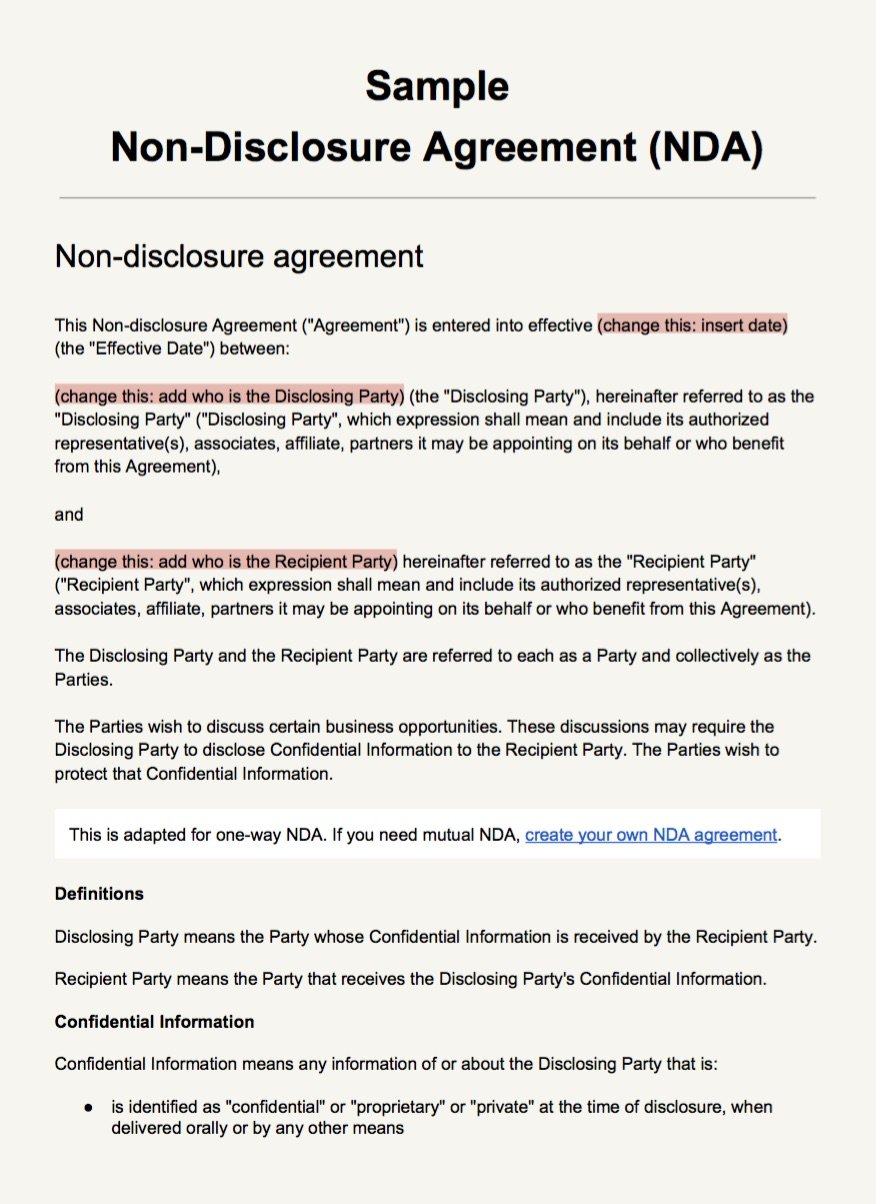
Credits: Icon contract document by creative outlet from the Noun Project.
Nov 30, 2018 | Non-disclosure Agreements
This article is not a substitute for professional legal advice. This article does not create an attorney-client relationship, nor is it a solicitation to offer legal advice.